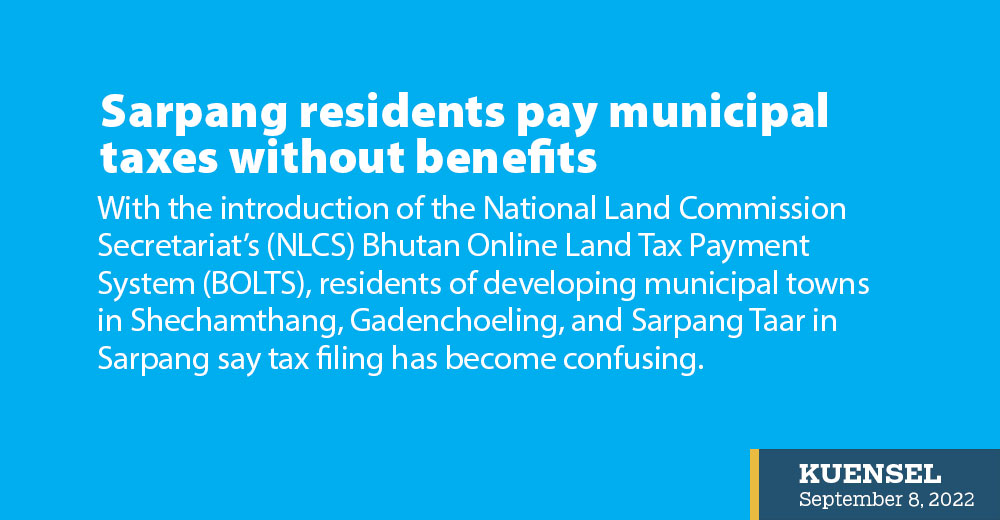Choki Wangmo | Sarpang
With the introduction of the National Land Commission Secretariat’s (NLCS) Bhutan Online Land Tax Payment System (BOLTS), residents of developing municipal towns in Shechamthang, Gadenchoeling, and Sarpang Taar in Sarpang say tax filing has become confusing.
They said that without the facilities or amenities of a municipal town, they have to pay municipal taxes, which are comparatively higher than the rural land taxes they used to pay.
The local government leaders of Gakiling and Shompangkha gewogs, at the dzongkhag tshogdu (DT) recently, requested that the BOLTS for these towns be turned off until the township development works are complete.
Gakiling Gup Nim Dorji said that as these towns do not have access to facilities of a municipal area, residents were exempted from paying municipal tax according to the decisions taken in a past DT.
“The gewog administration collected the rural taxes. As the taxes collected by the gewog administration wasn’t reflected in the BOLTS, many residents had to pay fines,” he said.
Shompangkha Mangmi Ashman Rai said that the public was not able to pay the municipal land tax as they don’t have income from the municipal land.
Individuals with plots in the municipal area had to pay as high as Nu 3,000 for a 15 decimal land. Some reportedly paid Nu 24,000 for an acre of land in the municipal area. The rural land tax is Nu 12 per acre.
Until 2019, the taxes were collected by the gewog administration.
A resident of Sarpang Taar, Phurba Dorji, said that there was no clear demarcation between Sarpang Taar and Shechamthang towns. The towns are 3km apart.
“While filing our taxes, we are juggling between the gewog administration and the municipal office,” he said, adding that they were not reaping the benefits of a municipal town. “It is confusing.”
Shechamthang town, the commercial hub of Sarpang dzongkhag falls under Gakiling gewog.
For the past 15 years, residents of Sarpang Taar (dzong area), supposed to be a residential area, did not get approvals to construct houses, affecting the development in the area.
“Residents were not given new business licenses even. For the public to pay municipal taxes, they have to earn from their plots,” Ashman Rai said.
Currently, Sarpang Taar has 55 business license holders.
The decision from the DT instructed that as these towns had no municipal facilities, the residents should pay the rural land tax. Dzongkhag’s land record officer was asked to submit an application to the NLCS to clear the lapses caused by the BOLTS.
Despite the notable development progress at the new township at Shechamthang, identified as a dzongkhag’s commercial hub, people have shared concerns regarding the commercial viability at the new location.
While the technical design for the new town, which is provisioned for 25 years, began in 2010, relocation began following the July 2016 flash flood in Sarpang that destroyed most of the Sarpang market then.
Business operators say there are no customers mainly because the new town is located far away from the primary settlement, which is at Taar.
Spread across an area of 223 acres above the Sarpang checkpoint, Shechamthang local area plan (LAP) is divided into 522 plots.


